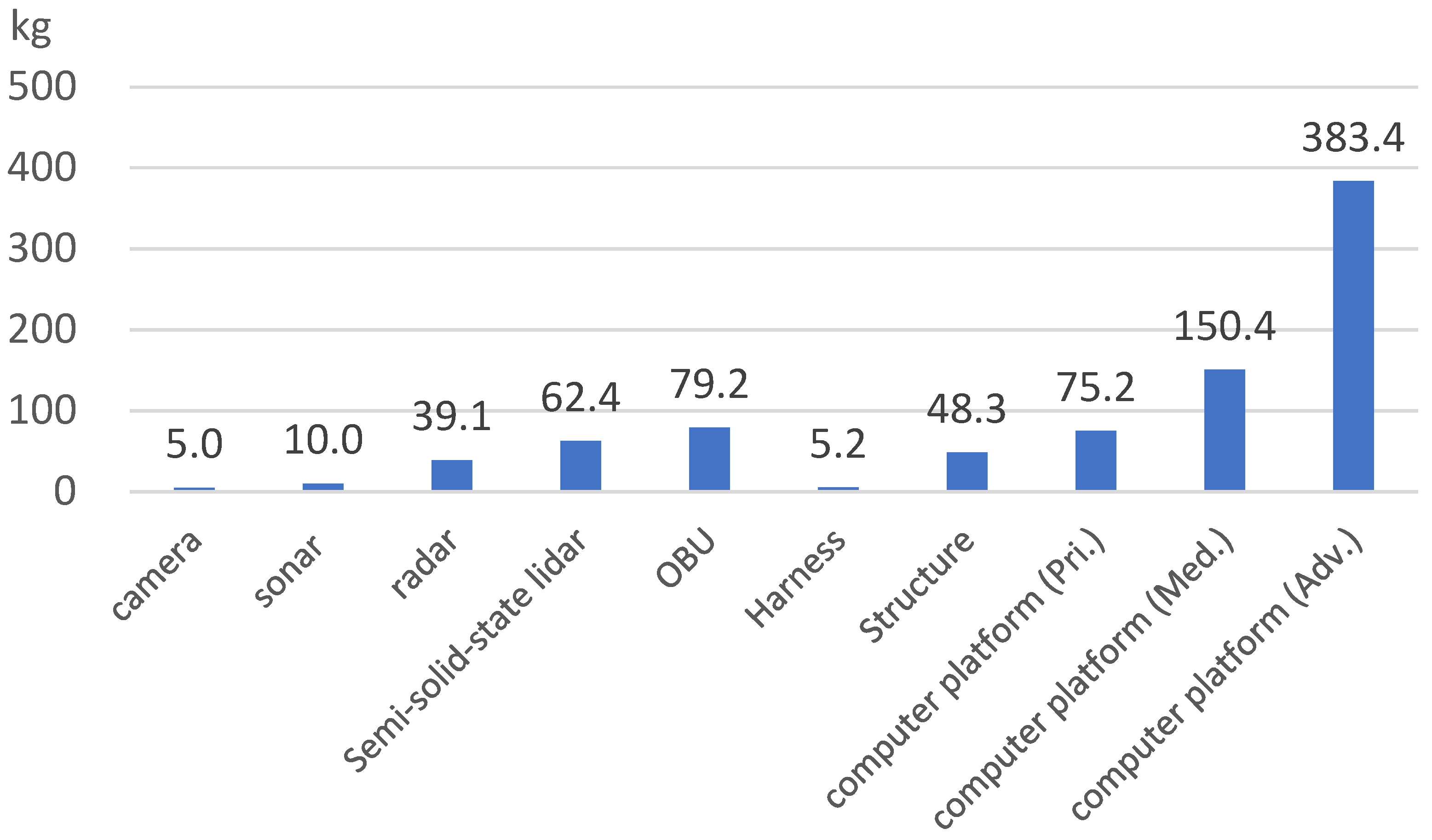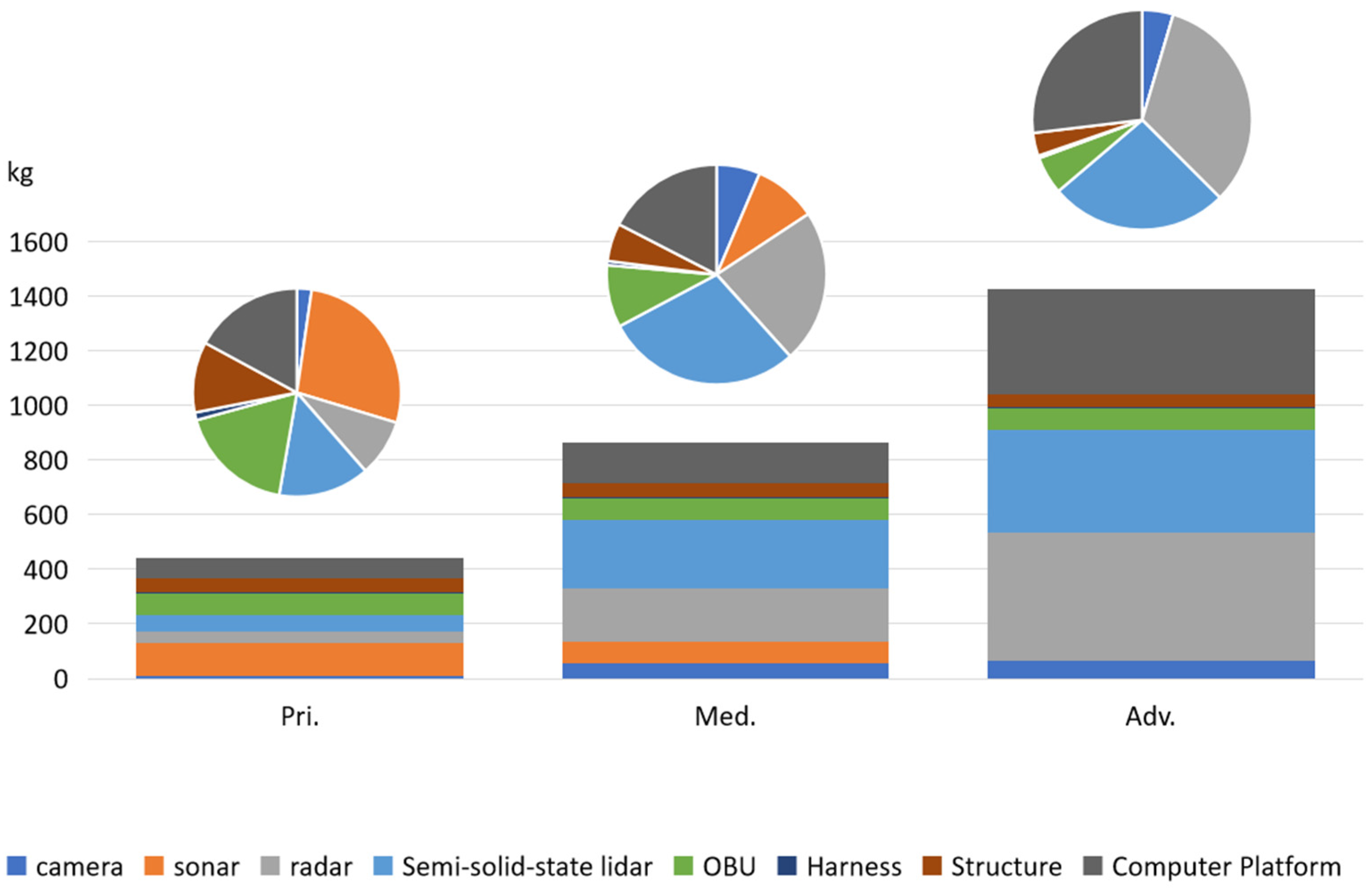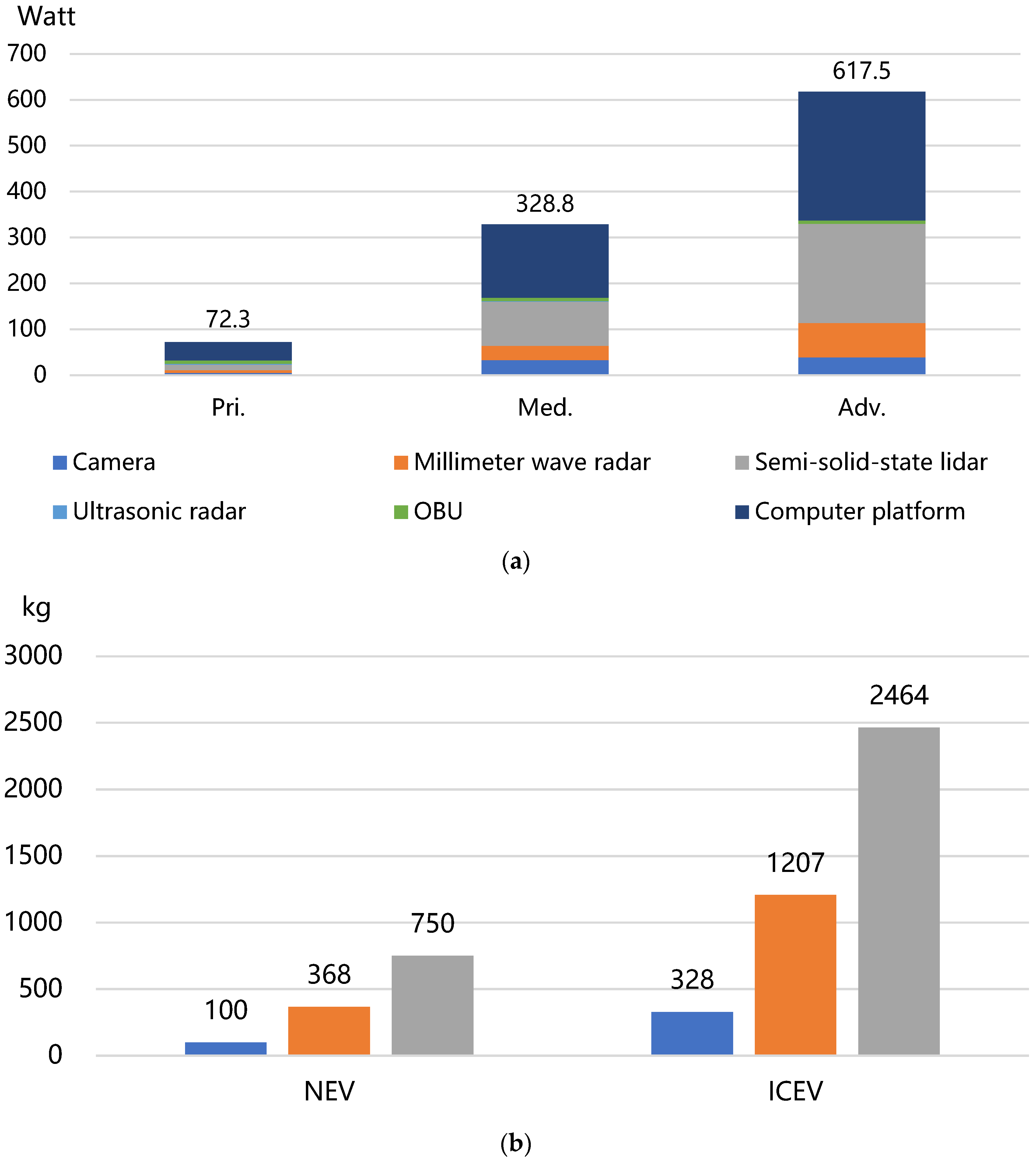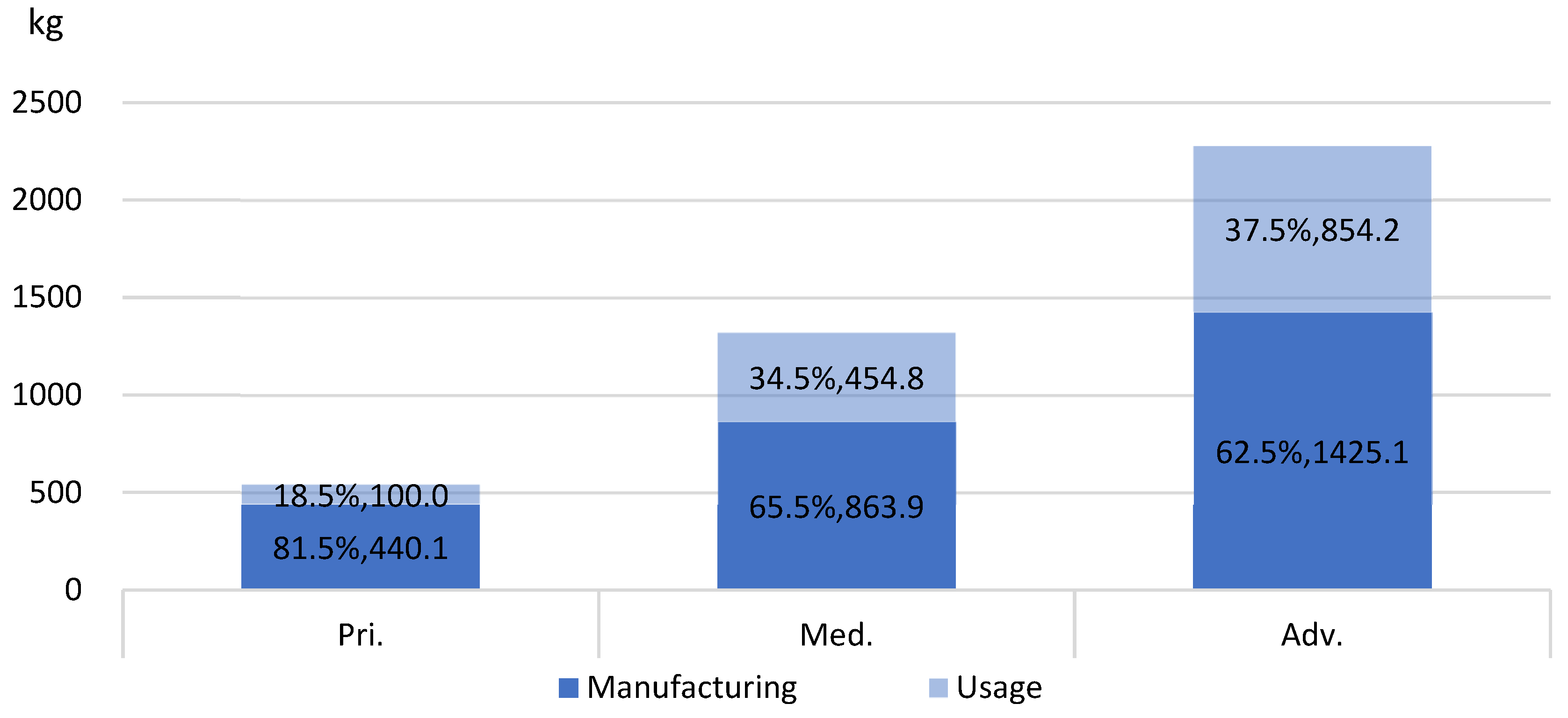A Greenhouse Gas Footprint Analysis of Advanced Hardware Technologies in Connected Autonomous Vehicles
Abstract
:1. Introduction
2. Methodology
2.1. Brief Description of Connected Autonomous Vehicles
2.1.1. Definition of Connected Autonomous Vehicles
2.1.2. Introduction to the Sub-Function Sets
2.1.3. Component Description of Connected Autonomous Vehicles
2.2. Scope
2.3. Method and Assumptions
- The architectural layout of the computing unit is assumed to be similar to that of a full-size desktop computer, with similar types of electronic components arranged in similar densities on the motherboard (however, there are unique structural requirements for heat dissipation, enclosure, and structural component parts on passenger cars, which are not referenced in full-size desktop computers).
- High-process chip carbon emissions do not decrease due to changes in grid carbon emissions. The main reason is that there is no major power grid system reform plan in the region where the major chip production factories are located, and there is no carbon peak, carbon neutral commitment, or decree in the country where they are located.
- In terms of environmental sensing, although the current mainstream technology routes include pure vision-based technology routes (e.g., Tesla), and LiDAR-based fusion technology routes equipped with cameras, millimeter-wave radar, and ultrasonic radar (most mainstream car companies), at present, the pure vision technology route makes it difficult to support advanced automatic driving. This paper is focused on intermediate and advanced automatic driving hardware assumptions based on the fusion technology route, and the assumption of the types and amount of hardware on behalf of the guarantee function can be realized, thus achieving a more moderate level of technology.
- For laser radar, although there have been much research into and development of the automatic driving function of the car enterprise or the internet enterprise, all of these developments use mechanical laser radar, such as Waymo, Apollo, etc., but according to the analysis in Section 3 and the current Chinese market within the market model products, mechanical laser radar, due to its structural characteristics and cost issues, will not be applied to the market vehicle. Thus, all the car laser radars are assumed to be semi-solid or all-solid laser radar.
- For each major production material (e.g., steel, aluminum, copper, glass, plastic, etc.), the carbon emissions are assumed to be based on the average level of the corresponding industries in China around 2020 according to the conclusions of existing studies.
3. Data and Calculation
3.1. Hardware System Decomposition
- Current status of commercially available products: currently commercially available models are mainly equipped with primary automated driving hardware, and a full set of sensors, computing platforms, and actuators, and other components are important references for the types and quantities of future system hardware.
- Basic functional requirements: there are basic physical requirements for future automatic driving sensor arrangement, i.e., each means of detection can cover all directions in two dimensions, multi-point arrangement, and hardware with redundancy, and intermediate and advanced automatic driving should be set up in the main direction with sufficient redundancy.
- Reasonable prediction: for example, due to the increase in sensors and the increase in model volume, intermediate and advanced automatic driving requires a significant increase in arithmetic power, which is far more than the decrease in arithmetic power demand that can be brought about by the optimization of the model; even if the telematics network has been popularized, in order to ensure that the automatic driving function can be guaranteed under all road infrastructure conditions, car companies generally will not reduce the intelligent configuration of a single vehicle.
3.2. Life Cycle Emissions’ Calculation
3.2.1. Production Stage
3.2.2. Emission Calculation of Usage Phase
4. Results
5. Conclusions and Discussion
5.1. Conclusions
5.2. Discussion
6. Outlook
Author Contributions
Funding
Institutional Review Board Statement
Informed Consent Statement
Data Availability Statement
Conflicts of Interest
Abbreviations
| GDP | Gross Domestic Product |
| GHG | Greenhouse gas |
| NEV | New energy vehicle |
| BEV | Battery electric vehicles |
| PHEV | Plug-in hybrid electrical vehicle |
| CAV | Connected autonomous vehicle |
| BEV | Battery electrical vehicle |
| OEM | Original equipment manufacturer |
| GPS | Global positioning system |
| GPU | Graphics processing units |
| TPU | Tensor processing units |
| DA | Driver assistance |
| PA | Partial driving automation |
| CA | Conditional driving automation |
| HA | High driving automation |
| FA | Full driving automation |
| Pri. | Connected and autonomous system that is classified as primary |
| Med. | Connected and autonomous system that is classified as medium |
| Adv. | Connected and autonomous system that is classified as primary |
| LiDAR | Light detection and ranging |
| IC | Integrated circuit |
| Emissions of IC during the production stage (kgCO2eq) | |
| Process of the computer chip (nm) | |
| The emission of CAV hardware system in the production stage | |
| Producing emissions of th material, th component (kgCO2eq/kg) | |
| The weight ratio of th material in th component (%) | |
| The weight of component th (kg) | |
| The number of components th used in the hardware system | |
| Emissions of connected and autonomous driving systems on ICEVs during the using phase (kgCO2eq) | |
| Power consumption of connected and autonomous driving system level (W) | |
| Efficiency for alternators of ICEVs | |
| Life cycle emissions of fuel consumption (kgCO2eq/MJ) | |
| Total time of system operation in using phase (h) | |
| Life cycle emissions of electricity used kgCO2/kWh |
References
- Central People’s Government of the People’s Republic of China. Ministry of Industry and Information Technology Released 2010 Automotive Industry Economic Report. Available online: https://www.gov.cn/govweb/gzdt/2011-01/18/content_1787053.htm (accessed on 28 November 2023).
- Ministry of Industry and Information Technology of the People’s Republic of China. Ministry of Industry and Information Technology released 2022 Automotive Industry Economic Report. Available online: https://www.miit.gov.cn/jgsj/zbys/qcgy/art/2023/art_ff136c2c686a4728a4905e62a7e991d6.html (accessed on 28 November 2023).
- Franzò, S.; Nasca, A. The environmental impact of electric vehicles: A novel life cycle-based evaluation framework and its applications to multi-country scenarios. J. Clean. Prod. 2021, 315, 128005. [Google Scholar] [CrossRef]
- China Petroleum and Chemical Industry Federation. China’s External Oil Dependence Soars to 73%. Available online: http://www.cpcif.org.cn/detail/d6e86fef-4cc9-4e66-815f-d00c2849e4af (accessed on 4 December 2023).
- International Energy Agency. Key Energy Statistics; Annual; International Energy Agenc: Paris, France, 2020. [Google Scholar]
- UNFCCC Secretariat. Report of the Conference of the Parties on Its Twenty-First Session, Held in Paris from 30 November to 13 December 2015; UNFCCC Secretariat: Paris, France, 2016. [Google Scholar]
- Zhao, F.; Liu, X.; Zhang, H.; Liu, Z. Automobile Industry under China’s Carbon Peaking and Carbon Neutrality Goals: Challenges, Opportunities, and Coping Strategies. J. Adv. Transp. 2022, 2022, 5834707. [Google Scholar] [CrossRef]
- International Energy Agency. CO2 Emissions in 2022. Available online: https://www.iea.org/reports/co2-emissions-in-2022 (accessed on 4 November 2023).
- Ternel, C.; Bouter, A.; Melgar, J. Life cycle assessment of mid-range passenger cars powered by liquid and gaseous biofuels: Comparison with greenhouse gas emissions of electric vehicles and forecast to 2030. Transp. Res. Part D Transp. Environ. 2021, 97, 102897. [Google Scholar] [CrossRef]
- Good Car Bad Car. 2023 U.S Auto Sales Figures—By Manufacturer (Automaker Rankings). Available online: https://www.goodcarbadcar.net/2023-us-auto-sales-figures-by-manufacturer/ (accessed on 25 March 2023).
- European Automobile Manufacturers’ Association. EU Car Sales on the up in 2023, with Electric Models Increasingly Popular. Available online: https://www.acea.auto/video/eu-car-sales-on-the-up-in-2023-with-electric-models-increasingly-popular/ (accessed on 14 January 2024).
- Irle, R. Global EV Sales for 2023. Available online: https://www.ev-volumes.com/news/global-ev-sales-for-2022/ (accessed on 25 March 2023).
- Yuan, X.; Zuo, J. Transition to low carbon energy policies in China—From the Five-Year Plan perspective. Energy Policy 2011, 39, 3855–3859. [Google Scholar] [CrossRef]
- Kim, S.-H.; Park, S.-H.; Lim, S.-R. Identification of principal factors for low-carbon electric vehicle batteries by using a life cycle assessment model-based sensitivity analysis. Sustain. Energy Technol. Assess. 2024, 64, 103683. [Google Scholar] [CrossRef]
- Malozyomov, B.V.; Kukartsev, V.V.; Martyushev, N.V.; Kondratiev, V.V.; Klyuev, R.V.; Karlina, A.I. Improvement of Hybrid Electrode Material Synthesis for Energy Accumulators Based on Carbon Nanotubes and Porous Structures. Micromachines 2023, 14, 1288. [Google Scholar] [CrossRef] [PubMed]
- Rahman, M.M.; Thill, J.-C. Impacts of connected and autonomous vehicles on urban transportation and environment: A comprehensive review. Sustain. Cities Soc. 2023, 96, 104649. [Google Scholar] [CrossRef]
- Nunes, A.; Axhausen, K.W. Road safety, health inequity and the imminence of autonomous vehicles. Nat. Mach. Intell. 2021, 3, 654–655. [Google Scholar] [CrossRef]
- Rios-Torres, J.; Malikopoulos, A.A. A Survey on the Coordination of Connected and Automated Vehicles at Intersections and Merging at Highway On-Ramps. IEEE Trans. Intell. Transp. Syst. 2017, 18, 1066–1077. [Google Scholar] [CrossRef]
- Bansal, P.; Kockelman, K.M. Forecasting Americans’ long-term adoption of connected and autonomous vehicle technologies. Transp. Res. Part A Policy Pract. 2017, 95, 49–63. [Google Scholar] [CrossRef]
- Butt, F.A.; Chattha, J.N.; Ahmad, J.; Zia, M.U.; Rizwan, M.; Naqvi, I.H. On the Integration of Enabling Wireless Technologies and Sensor Fusion for Next-Generation Connected and Autonomous Vehicles. IEEE Access 2022, 10, 14643–14668. [Google Scholar] [CrossRef]
- Narayanan, S.; Chaniotakis, E.; Antoniou, C. Shared autonomous vehicle services: A comprehensive review. Transp. Res. Part C Emerg. Technol. 2020, 111, 255–293. [Google Scholar] [CrossRef]
- Howard, D.; Dai, D. Public Perceptions of Self-driving Cars: The Case of Berkeley, California. In Proceedings of the Transportation Research Board 93rd Annual Meeting, Washington, DC, USA, 12–16 January 2014; p. 14-4502. [Google Scholar]
- Loke, S.W. Cooperative Automated Vehicles: A Review of Opportunities and Challenges in Socially Intelligent Vehicles Beyond Networking. IEEE Trans. Intell. Veh. 2019, 4, 509–518. [Google Scholar] [CrossRef]
- Wang, W.; Guo, K.; Cao, W.; Zhu, H.; Nan, J.; Yu, L. Review of Electrical and Electronic Architectures for Autonomous Vehicles: Topologies, Networking and Simulators. Automot. Innov. 2024, 7, 82–101. [Google Scholar] [CrossRef]
- Xia, N.; Yang, C.-S. Vehicular Communications: Standards and Challenges. In Proceedings of the Internet of Vehicles: Technologies and Services for Smart Cities, Kanazawa, Japan, 22–25 November 2017; pp. 1–12. [Google Scholar]
- On-Road Automated Driving Committee. Taxonomy and Definitions for Terms Related to On-Road Motor Vehicle Automated Driving Systems; SAE International: Warrendale, PA, USA, 2014. [Google Scholar]
- National Technical Committee of Auto Standardization. Taxonomy of Driving Automation for Vehicles; National Technical Committee of Auto Standardization: Beijing, China, 2021. (In Chinese) [Google Scholar]
- J3016_202104; Definitions for Terms Related to Driving Automation Systems for On-Road Motor Vehicles. SAE International: Warrendale, PA, USA, 2021.
- Technology Energy Saving and New Energy Vehicles Strategic Advisory Committee. Technology Roadmap for Energy Saving and New Energy Vehicles 2.0, 2nd ed.; Technology Energy Saving and New Energy Vehicles Strategic Advisory Committee: Beijing, China, 2021. (In Chinese) [Google Scholar]
- Touchton, B.; Galluzzo, T.; Kent, D.; Crane, C. Perception and Planning Architecture for Autonomous Ground Vehicles. Computer 2006, 39, 40–47. [Google Scholar] [CrossRef]
- Ignatious, H.A.; Sayed, H.-E.; Khan, M. An overview of sensors in Autonomous Vehicles. Procedia Comput. Sci. 2022, 198, 736–741. [Google Scholar] [CrossRef]
- Klette, R. Concise Computer Vision; Springer: London, UK, 2014. [Google Scholar]
- Fu, M.; Zhu, M.; Yang, Y.; Song, W.; Wang, M. LiDAR-based vehicle localization on the satellite image via a neural network. Robot. Auton. Syst. 2020, 129, 103519. [Google Scholar] [CrossRef]
- Bojarski, M.; Testa, D.D.; Dworakowski, D.; Firner, B.; Flepp, B.; Goyal, P.; Jackel, L.D.; Monfort, M.; Muller, U.; Zhang, J.; et al. End to End Learning for Self-Driving Cars. arXiv 2016, arXiv:1604.07316. [Google Scholar]
- Wang, S.; Jia, D.; Weng, X.J.A. Deep Reinforcement Learning for Autonomous Driving. arXiv 2018, arXiv:1811.11329. [Google Scholar]
- Rajamani, R. Vehicle Dynamics and Control; Springer Science & Business Media: Berlin, Germany, 2012. [Google Scholar]
- Zeadally, S.; Hunt, R.; Chen, Y.-S.; Irwin, A.; Hassan, A. Vehicular ad hoc networks (VANETS): Status, results, and challenges. Telecommun. Syst. 2012, 50, 217–241. [Google Scholar] [CrossRef]
- T/CSAE 53-2017; Cooperative Intelligent Transportation System; Vehicular Communication; Application Layer Specification and Data Exchange Standard. China Society of Automotive Engineers: Beijing, China, 2017.
- Muckenhuber, S.; Softic, K.; Fuchs, A.; Stettinger, G.; Watzenig, D. Sensors for Automated Driving. In Autonomous Vehicles: Business, Technology and Law; Van Uytsel, S., Vasconcellos Vargas, D., Eds.; Springer Nature: Singapore, 2021; pp. 115–146. [Google Scholar]
- Wang, M.; Elgowainy, A.; Lu, Z.; Bafana, A.; Benavides, P.T.; Burnham, A.; Cai, H.; Dai, Q.; Gracida, U.; Hawkins, T.R.; et al. Greenhouse Gases, Regulated Emissions, and Energy Use in Technologies Model; Computer software; 9 October 2020. Available online: https://www.osti.gov/doecode/biblio/43903 (accessed on 25 April 2024).
- Baitz, M.; Colodel, C.; Kupfer, T.; Pflieger, J.; Schuller, O.; Hassel, F.; Kokborg, M.; Köhler, A.; Stoffregen, A. GaBi Database & Modelling Principles 2012. Available online: http://gabi-6-lci-documentation.gabi-software.com/xml-data/external_docs/GaBiModellingPrinciples.pdf (accessed on 6 April 2024).
- Zhang, H.; Zhao, F.; Hao, H.; Liu, Z. Comparative Analysis of Life Cycle Greenhouse Gas Emission of Passenger Cars: A Case Study in China. SSRN 2022, 1–21. [Google Scholar] [CrossRef]
- He, P.; Feng, H.; Chhipi-Shrestha, G.; Hewage, K.; Sadiq, R. Life Cycle Assessment of e-Waste—Waste Cellphone Recycling. In Electronic Waste; Wiley: Hoboken, NJ, USA, 2022; pp. 231–253. [Google Scholar]
- Ou, S.; Yu, R.; Lin, Z.; Ren, H.; He, X.; Przesmitzki, S.; Bouchard, J. Intensity and daily pattern of passenger vehicle use by region and class in China: Estimation and implications for energy use and electrification. Mitig. Adapt. Strateg. Glob. Change 2019, 25, 307–327. [Google Scholar] [CrossRef]
- Singh, A. Vision-RADAR fusion for Robotics BEV Detections: A Survey. In Proceedings of the 2023 IEEE Intelligent Vehicles Symposium (IV), Anchorage, AK, USA, 4–7 June 2023; pp. 1–7. [Google Scholar]
- Sun, P.; Kretzschmar, H.; Dotiwalla, X.; Chouard, A.; Patnaik, V.; Tsui, P.; Guo, J.; Zhou, Y.; Chai, Y.; Caine, B.; et al. Scalability in Perception for Autonomous Driving: Waymo Open Dataset. In Proceedings of the 2020 IEEE/CVF Conference on Computer Vision and Pattern Recognition (CVPR), Seattle, WA, USA, 13–19 June 2020; pp. 2443–2451. [Google Scholar]
- Baidu Apollo. Baidu Apollo Self Driving Openness White Paper 1.0; Baidu Apollo: Beijing, China, 2023; p. 27. [Google Scholar]
- Huawei, A. AITO M7. Available online: https://aito.auto/model/m7/ (accessed on 4 December 2023).
- Tesla. Model 3 Lease starting at $329/mo*. Available online: https://www.tesla.com/model3 (accessed on 21 December 2023).
- Flir, T. Chameleon3 USB3. Available online: https://www.flir.cn/products/chameleon3-usb3/ (accessed on 6 December 2023).
- Continental. Autonomous Mobility ARS510. Available online: https://www.continental-automotive.com/en/components/radars/long-range-radars/advanced-radar-sensor-ars51x.html (accessed on 1 October 2023).
- Hesai. FT120 Solid State Ultra Wide Angle Near Range Lidar. Available online: https://www.hesaitech.com/cn/zh/FT120 (accessed on 10 October 2023).
- Bosch. Ultrasonic Sensor. Available online: https://www.bosch-mobility.com/en/solutions/sensors/ultrasonic-sensor/ (accessed on 13 October 2023).
- NVIDIA. NVIDIA DRIVE End-to-End Platform Designed for the Software-Defined Automobile. Available online: https://www.nvidia.cn/self-driving-cars/ (accessed on 4 January 2024).
- Gawron, J.H.; Keoleian, G.A.; De Kleine, R.D.; Wallington, T.J.; Kim, H.C. Life Cycle Assessment of Connected and Automated Vehicles: Sensing and Computing Subsystem and Vehicle Level Effects. Environ. Sci. Technol. 2018, 52, 3249–3256. [Google Scholar] [CrossRef] [PubMed]
- Krishnan, N.; Boyd, S.; Somani, A.; Raoux, S.; Clark, D.; Dornfeld, D. A Hybrid Life Cycle Inventory of Nano-Scale Semiconductor Manufacturing. Environ. Sci. Technol. 2008, 42, 3069–3075. [Google Scholar] [CrossRef]
- Rizvi, S.; Diebold, A.C.; Dhudshia, V.H.; Sun, Y.-P.; Foster, L.W.; Baumann, R.; Wood, S.C.; Barna, G.G. Handbook of Semiconductor Manufacturing Technology; Nishi, Y., Doering, R., Eds.; CRC Press: Boca Raton, FL, USA, 2008. [Google Scholar]
- Boyd, S.; Horvath, A.; Dornfeld, D. Life-cycle assessment of computational logic produced from 1995 through 2010. Environ. Res. Lett. 2010, 5, 014011. [Google Scholar] [CrossRef]




| National Technical Committee of Auto Standardization (China) [27] | SAE International [28] |
|---|---|
| L0: Emergency assistance | Level 0 (L0): No Driving Automation |
| L1: Partial driver assistance | Level 1 (L1): Driver Assistance (DA) |
| L2: Combined driver assistance | Level 2 (L2): Partial Driving Automation (PA) |
| L3: Conditionally automated driving | Level 3 (L3): Conditional Driving Automation (CA) |
| L4: Highly automated driving | Level 4 (L4): High Driving Automation (HA) |
| L5: Fully automated driving | Level 5 (L5): Full Driving Automation (FA) |
| Company | Name of Solution or Vehicle Model | Level | Camera | Radar | Lidar | Ultrasonic Radar | Computing Chipset or SOC |
|---|---|---|---|---|---|---|---|
| Waymo [45,46] (Mountain View, CA, USA) | waymo driver | Adv. | 29 | 6 | 5 | 0 | Self-developed chip |
| Apollo [47] (Beijing, China) | Apollo City Driving Max | Med. | 11 | 5 | 2 | 12 | Freescale i.MX 6D/6Q, STM32F103 |
| Apollo Highway Driving Pro | Pri. | 9 | 5 | 0 | 12 | Freescale i.MX 6D/6Q, STM32F103 | |
| Huawei [48] (Shenzhen, China) | AITO M7 | Pri. | 11 | 3 | 1 | 12 | Huawei MDC610 |
| Tesla [49] (Austin, TX, USA) | Model 3 | Med. | 8 | 12 | 0 | 0 | FSD Chip |
| GM (Detroit, MI, USA) | Cruise | Med. | 14 | 8 | 5 | 10 | Snapdrago SA8540P SoC, SA9000P |
| XPENG (Beijing, China) | P7 | Med. | 13 | 5 | 0 | 12 | Xavier |
| Audi (Ingolstadt, Germany) | A8 | Med. | 6 | 5 | 1 | 12 | zFAS |
| Benz (Stuttgart, Germany) | EQS | Med. | 6 | 5 | 1 | 12 | Xavier |
| Li Auto (Beijing, China) | L9 | Pri. | 11 | 1 | 1 | 12 | Orin-X |
| Nio (Shanghai, China) | ES7 | Pri. | 11 | 5 | 1 | 12 | Orin (×4) |
| BMW (Munich, Germany) | iX3 | Pri. | 8 | 5 | 0 | 12 | Mobileye EyeQ4 |
| Components | Number | Average Power | Weight | Refer | ||||
|---|---|---|---|---|---|---|---|---|
| Pri. | Med. | Adv. | Pri. | Med. | Adv. | (g) | ||
| Camera | 6 | 11 | 13 | 2.5 | 3 | 3 | 36/27.9 | FLIR Blackfly (Teledyne FLIR, Goleta, CA, USA), Chameleon3 [50], ORYX (Saint-Jean-de-Moirans, France) |
| Millimeter-wave radar | 1 | 5 | 12 | 6.25 | 6.25 | 6.25 | 140 | Continental (Hannover, Germany) ARS441, ARS510 [51] |
| Solid-state LiDAR | 1 | 4 | 6 | 12 | 24 | 36 | 620 | Hesai (Shanghai, China) FT120 [52] |
| Ultrasonic radar | 12 | 8 | 0 | 0.13 | 0.13 | 0.13 | 50 | Bosch (Gerlingen-Schillerhöhe, Germany) Ultrasonic [53] |
| OBU | 1 | 1 | 1 | 7.5 | 7.5 | 7.5 | 420 | Confidentiality is required |
| computing platform | 1 | 1 | 1 | 40 | 140 | 200 | 400 | NVDIA (Santa Clara, CA, USA) [54] |
| Harness | 1 | - | 1000 | |||||
| Structure | 1 | - | 6000 | |||||
| Material | Steel | Cast Iron | Aluminum | Copper | Glass | Plastic | Rare Earth | Electronics |
|---|---|---|---|---|---|---|---|---|
| camera | 0% | 0% | 0% | 0% | 9% | 45% | 0% | 46% |
| sonar | 0% | 0% | 0% | 0% | 0% | 50% | 0% | 50% |
| radar | 0% | 0% | 0% | 0% | 0% | 30% | 0% | 70% |
| Mechanical LiDAR | 0% | 7% | 61% | 6% | 5% | 7% | 6% | 5% |
| Semi-solid-state LiDAR | 0% | 0% | 0% | 0% | 19% | 70% | 1% | 10% |
| OBU | 0% | 0% | 0% | 8% | 0% | 45% | 0% | 47% |
| Computer Harness | 0% | 2% | 70% | 6% | 0% | 4% | 2% | 16% |
| Structure | 0% | 0% | 0% | 100% | 0% | 0% | 0% | 0% |
Disclaimer/Publisher’s Note: The statements, opinions and data contained in all publications are solely those of the individual author(s) and contributor(s) and not of MDPI and/or the editor(s). MDPI and/or the editor(s) disclaim responsibility for any injury to people or property resulting from any ideas, methods, instructions or products referred to in the content. |
© 2024 by the authors. Licensee MDPI, Basel, Switzerland. This article is an open access article distributed under the terms and conditions of the Creative Commons Attribution (CC BY) license (https://creativecommons.org/licenses/by/4.0/).
Share and Cite
Zhang, H.; Zhao, F.; Song, H.; Hao, H.; Liu, Z. A Greenhouse Gas Footprint Analysis of Advanced Hardware Technologies in Connected Autonomous Vehicles. Sustainability 2024, 16, 4090. https://doi.org/10.3390/su16104090
Zhang H, Zhao F, Song H, Hao H, Liu Z. A Greenhouse Gas Footprint Analysis of Advanced Hardware Technologies in Connected Autonomous Vehicles. Sustainability. 2024; 16(10):4090. https://doi.org/10.3390/su16104090
Chicago/Turabian StyleZhang, Haoyi, Fuquan Zhao, Haokun Song, Han Hao, and Zongwei Liu. 2024. "A Greenhouse Gas Footprint Analysis of Advanced Hardware Technologies in Connected Autonomous Vehicles" Sustainability 16, no. 10: 4090. https://doi.org/10.3390/su16104090







